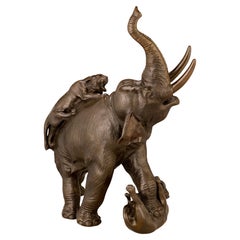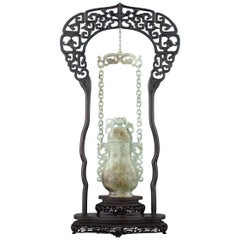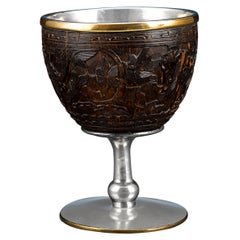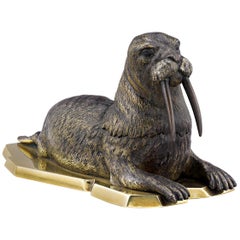Want more images or videos?
Request additional images or videos from the seller
1 of 5
Japanese Bronze Seated Monkey
$24,500List Price
About the Item
- Dimensions:Height: 10 in (25.4 cm)Width: 12 in (30.48 cm)Depth: 12 in (30.48 cm)
- Style:Meiji (Of the Period)
- Materials and Techniques:
- Place of Origin:
- Period:
- Date of Manufacture:19th Century
- Condition:
- Seller Location:New Orleans, LA
- Reference Number:Seller: 30-48831stDibs: LU89115129713
About the Seller
5.0
Recognized Seller
These prestigious sellers are industry leaders and represent the highest echelon for item quality and design.
Established in 1912
1stDibs seller since 2010
112 sales on 1stDibs
Typical response time: 8 hours
Authenticity Guarantee
In the unlikely event there’s an issue with an item’s authenticity, contact us within 1 year for a full refund. DetailsMoney-Back Guarantee
If your item is not as described, is damaged in transit, or does not arrive, contact us within 7 days for a full refund. Details24-Hour Cancellation
You have a 24-hour grace period in which to reconsider your purchase, with no questions asked.Vetted Professional Sellers
Our world-class sellers must adhere to strict standards for service and quality, maintaining the integrity of our listings.Price-Match Guarantee
If you find that a seller listed the same item for a lower price elsewhere, we’ll match it.Trusted Global Delivery
Our best-in-class carrier network provides specialized shipping options worldwide, including custom delivery.You May Also Like
Japanese Large Old Bronze Seated Buddha , Kyoto Hard To Find Gem
Located in South Burlington, VT
Japan, a fine large old seated Buddha, heavily hand cast bronze, with a fine medium to dark brown patina performing the mudra of compassion.
High quality, deep casting with fine ser...
Category
Mid-20th Century Japanese Showa Sculptures and Carvings
Materials
Bronze
$1,500 Sale Price
61% Off
H 25 in W 20 in D 18 in
Japanese Tokyo School Bronze Okimono of a Farmer, Meiji Period
Located in Austin, TX
A very fine and detailed Tokyo School cast bronze okimono (decorative sculpture) of a smiling farmer, Meiji period, late 19th century, Japan.
The e...
Category
Antique Late 19th Century Japanese Meiji Sculptures and Carvings
Materials
Bronze
Meiji period Japanese bronze Monkeys.
Located in Brighton, Sussex
These exquisite Japanese Meiji period sculptures depict two patinated bronze monkeys, showcasing the artistry and craftsmanship of the era. The larger monkey, seated with a contempla...
Category
Antique Late 19th Century Japanese Sculptures and Carvings
Materials
Bronze
A Japanese Bronze Monkey Smoking A Pipe
Located in Dallas, TX
A Japanese bronze monkey smoking a pipe. Early 20th century
Category
Early 20th Century Japanese Edo Sculptures and Carvings
Materials
Bronze
Pair of Japanese Gilt Bronze Komainu by Ishikawa Komei, Meiji Period
Located in Austin, TX
A striking pair of Japanese gilt bronze komainu by the renowned Japanese sculptor, Ishikawa Komei (1852-1913), Meiji period, Japan.
The pair well cast, and robustly modeled. They ar...
Category
Antique Late 19th Century Japanese Meiji Sculptures and Carvings
Materials
Bronze
$38,000 / set
H 13 in W 6 in D 9.5 in
Japanese Meiji Period Bronze Monkey Group Sculpture Okimono Shosai
Located in Newark, England
Featuring Seven Japanese Macaques
Form our Japanese collection, we are delighted to offer this Japanese Bronze Monkey Group by Shosai. The Japanese Bronze Group displaying a male father monkey and his infants playing around and being mischievous with Persimmon fruit. The monkeys modelled as Japanese macaque monkeys (snow monkey). The bronze okimono is beautifully patinated with a highly lifelike and naturalistic casting signed to the underside Shosai 正齊鋳. The Bronze group dates to the Meiji Period (1868-1912) circa 1885.
Japanese macaque (snow monkey) is a terrestrial Old World monkey species that is native to Japan. They are known as snow monkeys because some live in areas where snow covers the ground for long periods each year hence their nickname. No other non-human primate lives further north or in a colder climate than the snow monkey. Individuals have brownish grey fur, pinkish-red faces, and short tails. Two subspecies are known and their conservation Status is of least concern. In Japan, the species is known as Nihonzaru ニホンザル, 日本 (Japan/Nihon) and saru 猿 (monkey) to distinguish it from other primates, but the Japanese macaque is the only species of monkey in Japan.
The Japanese macaque features heavily in the religion, folklore, and art of Japan, as well as in proverbs and idiomatic expressions in the Japanese language. They are often seen in paintings, block prints and represented in all manner of carvings from Okimono to netsuke. Many of these art forms reside in the world’s most famous museums and collections, some of the most prominent pieces by artists such as Mori Sosen and Kawanabe Kyosai. In Shinto belief (Japan’s indigenous religion/nature religion) legendary mythical beasts known as raiju sometimes appeared as monkeys and kept Raijin (the god of lightning/storms) company. In another well known tale the three wise monkeys who warn people to “see no evil, hear no evil and speak no evil” can be seen depicted in relief over the door of the famous Tosho-gu shrine in Nikko.
Meiji Period was an era of Japanese history that spanned from 1868 to 1912. It was the first half of the Empire of Japan, when the Japanese people began to build a paradigm of a modern, industrialised nation state and emergent great power, influenced by Western countries and aesthetics. As a result of radically different ideas, the changes to Japan were profound and it affected the social structure, politics, economy, military, and foreign relations across the board. The period corresponded to the reign of Emperor Meiji and was preceded by the Keio era and was succeeded by the Taisho era.
Cultural Art during the Meiji Period was of particular interest to the government and they overhauled the art export market which in turn promoted Japanese arts via various world’s fairs, beginning in Vienna at the world fair in 1873. The government heavily funded the fairs and took an active role organising how Japan’s culture was presented to the world including creating a semi-public company named Kiritsu Kosho Kaisha (First Industrial Manufacturing Company). The Kiritsu Kosho Kaisha was used to promote and commercialise exports of Japanese art and established the Hakurankai Jimukyoku (Exhibition Bureau) to maintain quality standards. For the 1876 Centennial International Exhibition in Philadelphia, the Japanese government created a Centennial Office and sent a special envoy to secure space for the 30,000 items that would be displayed. The Imperial Household also took an active interest in arts and crafts, commissioning works by select artists to be given as gifts for foreign dignitaries further emphasising the high quality and importance of Japanese art. Just before the end of the 19th century in 1890, the Teishitsu Gigeiin (Artist to the Imperial Household) system was created to recognise distinguished artists. These artists were selected for their exceptionally high quality wares and talent in their own industry. Over a period of 54 years Seventy artists were appointed, amongst these were ceramicist Makuzu Kozan and cloisonné enamel artist...
Category
Antique Late 19th Century Japanese Meiji Sculptures and Carvings
Materials
Bronze
$20,581
Free Shipping
H 5.12 in W 7.09 in D 6.3 in
Japanese Gilt Seated Kannon Figure, circa 1850
Located in Chicago, IL
Intricately carved and finished with gilt black lacquer, this seated figure depicts the bodhisattva Guanyin, known in Japanese Buddhism as Kannon. Described as the "Buddha of Infinite Compassion," Kannon is the embodiment of mercy and makes himself available to all who call upon him with all their mind.
Kannon is depicted here seated in diamond position upon a double lotus plinth, set above a stepped base. He is dressed in gracefully draped robes and wears a tall crown bearing a minuscule figure of Amida, the Buddha of Infinite Light. He has a serene expression of calm and holds his right hand in the abhaya mudra, a gesture of comfort, blessing, and protection. Backed by a magnificent leaf-form nimbus, this Kannon figure...
Category
Antique Mid-19th Century Japanese Edo Sculptures and Carvings
Materials
Wood, Lacquer
Pair of Japanese Cast Bronze Figures of Niō, Meiji Period, Late 19th Century
Located in Austin, TX
A well cast pair of Japanese mixed metal okimono figures of Buddhist guardians, known as Nio or Dharmapala, protectors of Buddhist faith, Meiji Period, Japan.
The smiling bronze g...
Category
Antique Late 19th Century Japanese Meiji Sculptures and Carvings
Materials
Bronze
$1,750 / set
H 9 in W 4.5 in D 4 in
Japanese Hand Carved Monkey Family Sculpture Hear, See and Speak No Evil
Located in Douglas Manor, NY
1276 Japanese hand carved hardwood monkey family sculpture.
Fine detail.
Category
Mid-20th Century Sculptures and Carvings
Materials
Hardwood
$360 Sale Price
58% Off
H 6.5 in W 8 in D 5 in
Chinese Ming Style Bronze Metal Seated Buddha
Located in Rio Vista, CA
Diminutive Chinese bronze metal Buddha sculpture depicted sitting. Beautifully crafted in the Ming style with intricate details. The bronze has a rich pat...
Category
20th Century Chinese Ming Sculptures and Carvings
Materials
Metal, Bronze
More From This Seller
View AllJapanese Bronze Elephant and Tigers by Genryusai Seiya
Located in New Orleans, LA
Bronze Elephant and Tigers Genryusai Seiya
19th century
This extraordinary bronze sculpture by Genryusai Seiya, a master of the Meiji period, depicts a breathtaking battle between a...
Category
Antique 19th Century Japanese Meiji Animal Sculptures
Materials
Bronze
Jade Hanging Vase
Located in New Orleans, LA
This rare Chinese hanging vase, carved of fine moss-in-snow jade, boasts a host of dragons, the most potent symbols of good fortune in China. Its intricat...
Category
20th Century Chinese Other Sculptures and Carvings
Materials
Jade
$18,500
Chinese Coconut Cup
Located in New Orleans, LA
Carved from the shell of a coconut, this enchanting Chinese cup exhibits exceptional artistry. An elegant floral design encircles the entire cup, while the interior is fully lined with silver. In addition to the poison detecting powers attributed to coconuts, the Chinese believed that silver would tarnish when in contact with poison. In fact, many wealthy Chinese used silver lined cups and chopsticks tipped with silver fittings as an assurance against poisoning. To find a silver-lined coconut cup...
Category
Antique Early 19th Century Chinese Other Sculptures and Carvings
Materials
Coconut
$3,950
Vienna Bronze Walrus Inkwell
Located in New Orleans, LA
Wonderfully charming and boasting a high level of detail, this bronze walrus also serves as an inkwell. The incredible artistry of Viennese bronze work i...
Category
Antique Late 19th Century Austrian Other Inkwells
Materials
Bronze
Bronze Snake Charmer by Franz Bergman
By Franz Bergmann
Located in New Orleans, LA
Bronze Statue of a Snake Charmer
Franz Bergman
Early 20th Century
This captivating cold-painted bronze sculpture of a snake charmer is the work of the renowned Austrian sculptor Fra...
Category
Early 20th Century Austrian Figurative Sculptures
Materials
Bronze
Reclining Lady Erotic Bronze by Franz Bergmann
By Franz Bergmann
Located in New Orleans, LA
There is more to this enchanting Belle Époque figure than meets the eye. Crafted of bronze with cold-press enamel, this figure of a young woman lounging...
Category
Antique 19th Century Austrian Belle Époque Figurative Sculptures
Materials
Bronze
Recently Viewed
View AllMore Ways To Browse
Monkey Japan
Japanese Monkey
Meiji Bronze Monkey
Brienz Bear
Bronze Buffalo
Bronze Giraffe Sculpture
Carved Wood Camel
Ceramic Dog Statue
Ceramic Horse Head
Chinese Horse Terracotta
Cow Ceramic
Deco Terrier
Edouard Sandoz Porcelain
Elephant Saddle
French Faience Animals
Frog Pottery
Horse Sculpture Marble Base
Large White Ceramic Sculptures



